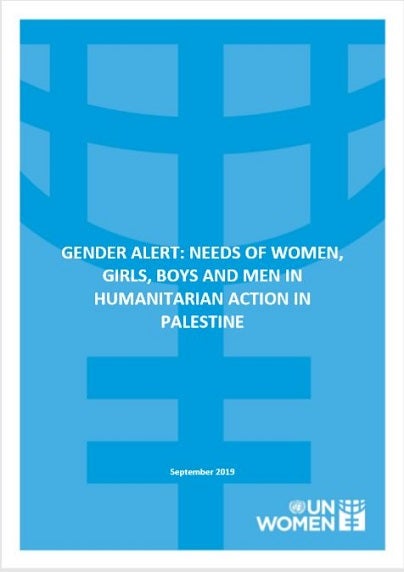
Gender Alert: Needs of Women, Girls, Boys and Men in Humanitarian Action in Palestine

In the oPt and around the world, there is an increasing recognition amongst humanitarian actors of the urgency to ensure that the different needs of women, girls, men and boys are taken into account and included in all humanitarian assistance (design, planning, implementation and monitoring). Failure to do so hampers an effective humanitarian response and may put beneficiaries’ lives at risk. According to IASC Gender Handbook for Humanitarian Action, integrating gender equality also reinforces a human rights-based approach to humanitarian action which improves programming by respecting and protecting the universally recognized rights and dignities of every individual as a human being. Incorporating gender equality in humanitarian action therefore enhances the impact of humanitarian strategies and interventions.
In the oPt, this has additional dimensions. The fluid political situation, the shifting vulnerabilities, the protracted occupation with its limitations on development and humanitarian action, all create additional layers of potential discrimination at all levels, in addition to social, cultural and economic factors. The Gaza Strip remains in a protracted and deep humanitarian crisis inflicted by the Israeli blockade and successive rounds of destructive conflict. By 2020, the UN projects that Gaza will be “unlivable.” Of a total population of 1.9 million people, 1.6 million or 64 per cent are estimated to be in need. The territory is facing a crisis of hyper-unemployment, food insecurity, electricity blackouts, sanitation disasters, and a failing medical sector. Cuts to the budget of the United Nations Relief and Works Agency (UNRWA), which serves 1.36 million refugees in Gaza, by the American administration and the cuts in the salaries of civil servants by the Palestinian Authority (PA) have further deepened the vulnerability of households. A total of 39 per cent of Palestinians in Gaza are living below the poverty line, more than double those in the West Bank (18 per cent). Only 10 per cent of households have “direct access to safe drinking water” and in December 2017, received only an average of 4-5 hours of electricity per day. These stresses have been linked to increased incidence of gender-based violence (GBV), including early marriage, while shelters and other service providers struggle to meet the needs with increasingly limited resources.
In the West Bank, 13.9 per cent of residents are living in poverty, including 5.8 per cent who are living in “deep poverty.” The burden of poverty falls hardest on several vulnerable groups, including: women-headed households, youth and children, people with disabilities, refugees, Bedouin, displaced persons, Area C, H2, East Jerusalem and the Seam Zone. In East Jerusalem, 75.4 per cent of families live below the Israeli poverty line, while as many as 33 per cent of Palestinian schoolchildren “do not complete 12 years of education.” In the West Bank, Palestinians are exposed to settler violence on a regular basis. Few areas, including classrooms, homes or hospitals are safe and Palestinians find themselves harassed, detained, and arrested by Israeli forces. In 2018, the Israeli military demolished 460 Palestinian structures, across the West Bank and East Jerusalem, and conducted an average of 172 search and arrest operations every two weeks. Israel controls all ground and surface water, allocating Palestinians a daily average 84.3 litres of water (in some cases, as low as 20), well below the 100 litre minimum recommended by the World Health Organization (WHO). In Area C, Palestinians are prohibited from building cisterns or other water retaining/collecting infrastructure without permits. Though the vast majority of the Palestinian population (95.0 per cent) is connected to an energy grid, Palestine is energy-insecure. The provision and control of Israel remains dependent on Israel, due to restrictions on building plants within the West Bank.